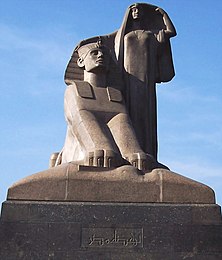Egyptian nationalism
Sanu was the first to write in Egyptian Arabic, which was intended to appeal to a mass audience, and his cartoons could be easily understood by even the illiterate.
Sanu fled to Paris, and continued to publish Abu-Naddara Zarqa there, with its issues being smuggled into Egypt until his death in 1912.
Along with this interest came an indigenous, Egypt-centered orientation, particularly among the Egyptian intelligentsia that would affect Egypt's autonomous development as a sovereign and independent nation-state.
Historian Robert O. Collins says: The most vigorous English advocate of Egyptian Independence, Blunt was both arrogant and irascible, his works scathing, discursive, and at times utterly ridiculous.
Immature and unfair, both he and his writings must be used with caution, but even the dullest of men will come away stimulated if not aroused and with fresh insights to challenge the sometimes smug attitudes of British officials in Whitehall and Cairo.
After the Entente Cordial of 1904 ended hopes of French support for Egyptian independence, a disillusioned Kamil looked east towards Japan as a model, defining Egypt as an "Eastern" country occupied by "Western" Great Britain, and suggested in terms that anticipated later Third World nationalism that Egyptians had more in common with people from other places controlled by Western nations such as British India (modern-day India, Pakistan, and Bangladesh) and the Dutch East Indies (modern-day Indonesia) than they did with the nations of Europe.
One of the more noteworthy cases of Egyptian nationalism occurred in December 1922 when the Egyptian government laid claim to the artifacts found in the tomb of King Tutankhamun, which had been discovered by a British archaeologist named Howard Carter in November 1922, arguing that they belonged to Egypt and Carter could not take them to Britain as he planned.
The dispute finally led to the Egyptians posting an armed guard outside of Tutankhamun's tomb to prevent Carter from entering it.
On 6 March 1924, the Prime Minister Saad Zaghloul formally opened the site of Tutankamun's tomb to the Egyptian public in an elaborate ceremony held at night with the sky lit up by floodlights, which reportedly attracted the largest crowd seen in Luxor.
At the same time, It was condemned by Hassan al-Banna, the founder and Supreme Guide of the Muslim Brotherhood, as glorifying a period of jahiliyyah.
In January 1952, British forces surrounded an Egyptian police station and demanded they surrender a group of fedayeen guerillas who had taken shelter there and leave the canal zone.
[9] After the Egyptian Revolution of 1952 that overthrew the monarchy and established a republic, Gamal Abdel Nasser rose to power on themes that were based on Arab nationalism.
Nasser saw himself as the successor of Mohammad Ali Pasha, who had sought to found a new dynasty to rule the Ottoman Empire in the 19th century.
[11]After the 1973 October War had boosted his image and the Egyptian army's image in Egypt, Sadat began a comprehensive attack on Nasser's legacy, including his pan-Arabist policies, which were portrayed as having dragged Egypt into poverty, a long grinding war in Yemen, and subservience to the Soviet Union.
Sadat had chosen to launch what Egyptians call the Ramadan/October War in 1973 during the Muslim holy month of Ramadan and the code-name for the initial assault on the Israeli Bar Lev Line on the Suez Canal was Operation Badr, after Muhammad's first victory, both gestures that would have been unthinkable under Nasser as Sadat chose to appeal to Islamic feelings.



